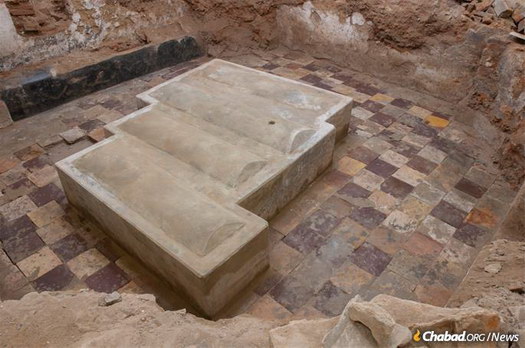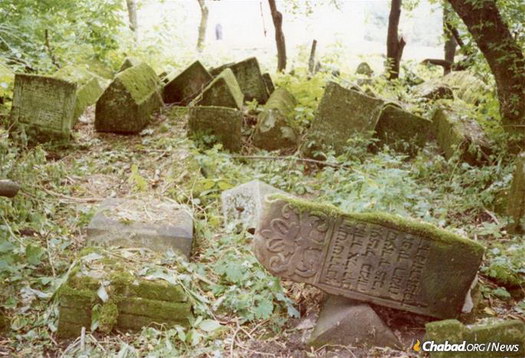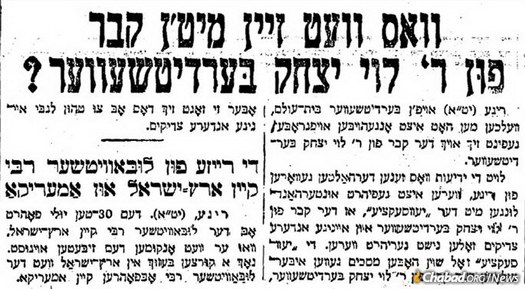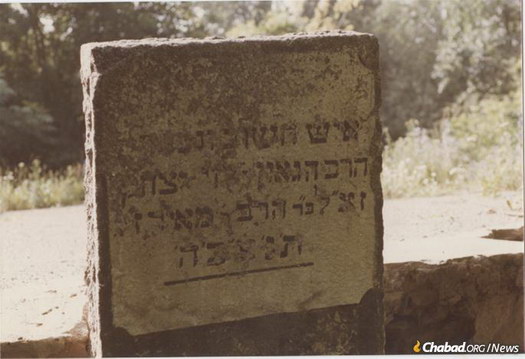
In Berdichev, They’ve Been Walking on the Grave of a Rabbi Who Couldn’t Care Less
by Dovid Margolin – chabad.org
In Eastern Europe, there is a truth that lurks just beneath the surface. Beyond the glitz of new developments and predating the drab grayness of Soviet-era construction lie remnants of a lost Jewish world and its inhabitants. Synagogues, yeshivahs, Jewish homes and businesses. Cemeteries and mass graves. It’s all there, buried under asphalt and overgrowth and deep within the recesses of memory.
No matter the attempts, modern or historic, malicious or pragmatic, to build over and erase all signs of Jewish life in the region’s villages, towns and cities, there is no escape. Like the landmines or unexploded bombs that emerge from time to time from this war or that, each discovery of a mezuzah mark, Hebrew inscription or Jewish gravestone in Eastern Europe reminds us once again that the past is never dead.
It’s the reason why Rabbi Moshe Thaler, director of Chabad-Lubavitch of Berdichev, Ukraine, and the city’s lone rabbi, was unsurprised when construction workers at the tomb of Rabbi Levi Yitzchak of Berdichev (1740-1809) suddenly hit something. It wasn’t just cement or dirt. It was a brick wall, beautiful and old. Thaler, supervising the work, instructed them to stop while he consulted rabbinic authorities on how to proceed.
Berdichev was once known as the Jewish capital of the Russian Empire—an ir ve’am b’Yisroel, or “a city and mother of Israel.” Eighty percent of its population was Jewish, even that figure being an understatement. “In fact,” wrote eyewitness Boris Bogen in 1923, “the city is entirely Jewish as the non-Jews live on the outskirts.”
There is, above all, one person whose name universally evokes Berdichev and with whom the small city’s story is forever intertwined: Rabbi Levi Yitzchak, the Berdichever. He was a student of Rabbi Dovber, the Maggid of Mezritch, the successor of the Baal Shem Tov—the founder of the Chassidic movement—and a contemporary and friend of Rabbi Schneur Zalman of Liadi, the founder of the Chabad-Lubavitch movement. Rabbi Levi Yitzchak and Rabbi Schneur Zalman were further connected by the bonds of family after two sets of their grandchildren married, each calling the other mechutan, “the inlaw.” While Rabbi Levi Yitzchak did not establish a dynastic Chassidic court, some of his teachings, published in Kedushat Levi, survived. More than anything else, however, it was his reputation as a fiery advocate for and lover of all Jews that has enshrined him in collective memory as the “defender of the Jewish people.”
100,000 Visitors a Year
Rabbi Levi Yitzchak’s resting place in Berdichev, two-and-a-half hours southwest of the capital of Kiev, has thus drawn Jewish pilgrims and petitioners for centuries—men and women beseeching the great rabbi to intercede on their behalf on High. Since the fall of Communism, Jews from around the world have beaten a path to Berdichev, some 100,000 visitors a year. Ukraine is cold in the winter, and the stone floor in his mausoleum can remain unbearably frigid even as temperatures outside turn warmer. As the coronavirus brought travel to a standstill, Thaler, who oversees the city’s Jewish cemetery, thought he could use the lull in visitors to place heating in the mausoleum’s floor.
Carefully and under Thaler’s watchful eye—even the minutest work at a Jewish cemetery needs rabbinic supervision to adhere with Jewish law and respect the sanctity of the place—the workers began to dig. After hitting the wall, Thaler heeded the rabbinic instructions he received that work recommence at an even slower pace. Following the path the wall took, the base of an entire structure emerged: four elegant plastered brick walls, a doorway on one side and a built-in stone bench opposite it. Next came a patterned tile floor. And then, finally, the rectangular outlines of four horizontal gravestones.
Thaler had discovered—some five feet below what was thought to have been the mausoleum floor—the original tomb constructed for Rabbi Levi Yitzchak, beside whom were buried his three sons, some two hundred years earlier.
The Jews of Berdichev had long been particularly poor. Yet somehow, for the honor of the great rabbi who had served them so faithfully and whose aura loomed large, funds had been gathered and local Jewish artisans had built this intricate edifice. And there it was.
“Until now, people who came to pray at Rabbi Levi Yitzchak’s gravesite were actually standing directly on top of the grave,” says Thaler. This, of course, is true, although Rabbi Levi Yitzchak, who went to extraordinary lengths to find the good in everyone—thieves and heretics included—would likely have been the last person to take offence. Now Thaler plans to restore the original.
As Chabad emissaries to Berdichev, Thaler and his wife, Chana, primarily work with the region’s living, breathing Jews, though the discovery helps put into focus their work and that of their colleagues throughout the former Soviet Union.
“When you’ve hit a person’s surface, you need to dig a little deeper,” Thaler considers. “You’ll be surprised by what you discover.”
How indeed did these layers come to conceal this holy place?
The story begins on 25 Tishrei, 5570 (the evening of Oct. 4, 1809, N.S.), when the soul of Rabbi Levi Yitzchak of Berdichev ascended to Heaven, throwing the Jewish townsfolk into mourning. “As they escorted him to the cemetery they saw a pillar of fire,” records Shalom Guttman in his 1909 biography, Tiferet Beit Levi. Guttman also reports that the sage’s three sons were buried alongside him.
“Over the grave of the great Berdichever Rav was erected a little synagogue [shtibel], and on it was inscribed nothing. Not one word,” writes Mendel Osherovich in his 1948 Shtet Un Shtetlekh in Ukraine (Cities and Towns of Ukraine). “This was … the wish of the deceased, who in his days had been a model of genuine humility.”
The Jews of Berdichev did not need a tombstone to tell them who lied buried there. “From generation to generation in Berdichev, they would relate that there, in that little synagogue in the cemetery, is the grave of Rabbi Levi Yitzchak. And during each time of danger, of great catastrophe, the Jews of Berdichev would go to his grave and cry and lament.” It was precisely during these times that they felt the loss of the great saint who had defended them not only before man, “but even before G‑d Himself.”
It would appear that this same little structure survived World War I; the brutal and bloody pogroms that colored the Russian Revolution and especially the Civil War; and into the dawn of the Bolshevik era. And then came the Communists’ blatant, frontal and brutal assault on Jewish life and practice. Tragically, in the first decade of Bolshevik rule, this unrelenting onslaught was led by the Yevsektzia, the Jewish sections of the Communist Party. Viciously, fanatically, they worked to uproot every vestige of the G‑d of Abraham, Isaac and Jacob, confiscating synagogues, violently beating rabbis and paving over Jewish cemeteries. The Yevsektzia was most powerful in traditionally Jewish areas, and there was no place more Jewish than Berdichev.
“The conversion of the two-hundred-year-old Jewish cemetery of Berditcheff [sic] into a public park has resulted in a war between religious Jews and policemen and laborers employed in excavating the cemetery and transforming it into a park,” the Jewish Telegraphic Agency (JTA) reported on July 12, 1929. While the city’s rabbinate proclaimed that ancient Jewish remains were being desecrated, “the Communists declare that … only the skeletons of horses have been dug up.” It does add, however, that a rumor had spread among workers that some of those who partook in the action had become paralyzed and a number of them refused to continue, fearing “God’s vengeance.”
“What Will Be With the Grave of R’ Levi Yitzchak Berdichever?” screamed a July 23 Yiddish headline in Warsaw’s Unzer Express. The article, also a JTA dispatch, reports that in response to the uproar, Berdichev’s Yevsektzia had agreed to “make a concession to the protesting Orthodox and to spare the grave of the popular Chassidic rabbi.”
There does appear to have been some confusion in the reporting, as Berdichev’s oldest cemetery was indeed destroyed and is today the city’s central Park Shevchenko. Perhaps due to the aforementioned workers’ fear, one grave remains—that of a legendary Berdichev rabbinical figure named Rav Liber the Great (d. 1771). Rabbi Levi Yitzchak, on the other hand, was buried in what was a relatively newer cemetery, destruction of which it seems the Yevsektzia did not get around to. In 1930, Stalin ordered the Yevsektzia disbanded, and by the end of the year Jewish Communists had lost their power in the city. (A high percentage of the outfits’ former members would be executed in Stalin’s terror of 1936-38.)
As Thaler understands it, some time after this episode and to head off the unthinkable destruction of Rabbi Levi Yitzchak’s grave, observant Jews in Berdichev themselves took down the brick mausoleum surrounding the grave and capped it with pavement and a headstone in order to make it less of a target.
When the Nazis entered Berdichev on July 7, 1941, about a third of its Jewish population had fled. Over the next months, they would murder the remaining 30,000 Jews from Berdichev and surrounding villages. They also actively violated Berdichev’s Jewish cemetery, breaking the fences and carting headstones away for construction use.
Rabbi Levi Yitzchak’s grave, however, remained.
Re-establishing a Sacred Memorial
Sofya Nayer, a mathematics professor living in Fair Lawn, N.J., was born in Berdichev in 1946. Her parents had survived the region’s Holocaust by bullets, returning to their hometown after the war to build a family. But Nayer’s father had been badly injured fighting with the Red Army. Sick for years, he passed away in 1959 and was buried in Berdichev.
“My mother would take my two sisters and I to the cemetery to visit my father,” Nayer recalls. “And each time afterwards, she’d take us past all the broken stones to this big, flat grave, and say, ‘Here is buried a very famous person.’ She never told us it’s a big rabbi; she was afraid.”
The fear Nayer’s mother felt was not unwarranted. Soviet persecution of Jewish religious practice—not to mention state-sanctioned anti-Semitism—was at full strength in the 1950s and ’60s, as the purposefully neglected and dilapidated Jewish cemetery testified.
Still, Nayer would recall her mother asking male passersby to say a prayer before they left, words she later came to recognize as Kel Maleh. Together with her husband, Nayer emigrated to the United States in the early 1980s, returning once in 1989 to visit her mother. The two again went out to the Jewish cemetery, which had only further deteriorated. By this time, however, Lubavitch activists had done the first restoration of Rabbi Levi Yitzchak’s gravesite, cleaning it and placing a new headstone above. Now Nayer knew the identity of the “famous man” her mother insisted on visiting, and she watched as her aging mother and Berdichev’s elderly Jews struggled, canes in hand, to reach Rabbi Levi Yitzchak.
Not long thereafter, and with Nayer’s help, a road was laid and a brick mausoleum was again built over Rabbi Levi Yitzchak’s resting place, adding another layer. An even larger one (the one in use until now) was constructed in 2002. Little did they know that the true grave had been sealed underground for its own protection, waiting to be revealed.
“The rav and tzaddik of Berdichev once said that if he were faced with a choice, to be alone in Gan Eden or to go to gehinnom [purgatory] but together with other Jews, he would choose to go to gehinnom,” the Rebbe—Rabbi Menachem M. Schneerson, of righteous memory—recounted in Yiddish at a 10 Shevat gathering in 1953. “For the main purpose is to be together with other Jews.”
Through czarist edicts, Ukrainian pogroms, Communist repression and Nazi depravity, Rabbi Levi Yitzchak has remained with his people in Berdichev.
“This is the nature of a shepherd of Israel,” the Rebbe said. “His entire being is his role as a leader of the Jewish people, and so matters of Gan Eden are of no concern to him. What does matter is to be together with the Jewish people, for this is his purpose and mission … .”
And so it is.
This article was reprinted with permission from chabad.org




















